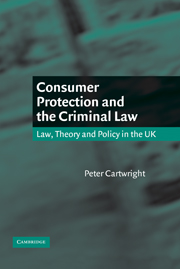Book contents
- Frontmatter
- Contents
- Preface
- Acknowledgements
- List of abbreviations
- 1 Consumer protection rationales
- 2 Techniques of regulation
- 3 The role of criminal sanctions in consumer protection
- 4 The use of the criminal law
- 5 Consumers and safety: the protection of physical integrity
- 6 The protection of economic interests
- 7 The enforcement of regulatory consumer law
- 8 Conclusions
- Index
4 - The use of the criminal law
Published online by Cambridge University Press: 24 June 2009
- Frontmatter
- Contents
- Preface
- Acknowledgements
- List of abbreviations
- 1 Consumer protection rationales
- 2 Techniques of regulation
- 3 The role of criminal sanctions in consumer protection
- 4 The use of the criminal law
- 5 Consumers and safety: the protection of physical integrity
- 6 The protection of economic interests
- 7 The enforcement of regulatory consumer law
- 8 Conclusions
- Index
Summary
Introduction
In the previous chapter, we examined some important questions about when something should be classed as criminal, and about what the criminal law, and punishment under it, are trying to achieve. We also looked at whether it is appropriate to try to identify a separate branch of the criminal law, known as regulatory crime. To understand the role of criminal law in protecting the consumer it is important to move on and look at the mechanisms that have been developed, primarily by the courts, to ensure that criminal offences can be used effectively to protect consumers and, in particular, to control businesses. There are three prime concepts of relevance here: strict liability, vicarious liability, and corporate liability. As will become apparent, the three are interlinked, in particular by the existence of due diligence defences. By examining these concepts, we can identify weaknesses in the structure of the criminal law, particularly where it is used against corporations. It will be argued that reform of the concepts of corporate and vicarious liability needs to be addressed if the law is to provide an appropriate degree of protection for consumers.
Strict liability
Defining strict liability
Strict liability is not the same as absolute liability, although the expressions have sometimes been used interchangeably. In Sweet v. Parsley, for example, Lord Reid used the phrase ‘absolute liability’ to mean that which would usually be called strict liability.
- Type
- Chapter
- Information
- Consumer Protection and the Criminal LawLaw, Theory, and Policy in the UK, pp. 87 - 125Publisher: Cambridge University PressPrint publication year: 2001



